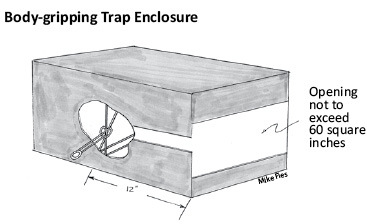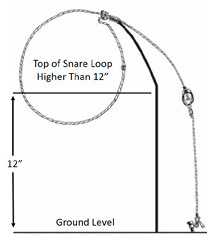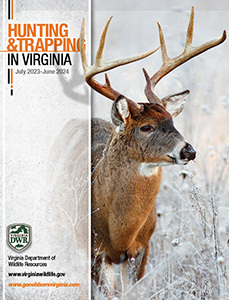Furbearer Trapping
General Trapping Regulations
- Residents under 16 years of age do not need a license to trap when accompanied by any person 18 years of age or older who possesses a valid state or county license to trap. Residents under 16 years of age who hold a resident junior trapping license are not required to be accompanied by a licensed adult while trapping. County residents 65 years of age and over do not need a license to trap on private property in their county of residence. Resident or nonresident landowners, and their spouses, children, grandchildren, spouses of such children and grandchildren, and the landowner’s parents do not need a license to trap within the boundaries of their own lands.
- Trapping is allowed on any day of the week, including Sundays. In addition, trappers may shoot wild animals caught in traps on any day of the week (including Sundays) in order to dispatch them. No additional license is required other than a valid Virginia trapping license (unless you are license exempt).
- Trapping on Department-owned or controlled lands and waters is allowed under the regulations of the Board unless prohibited by posted rules. The posted rules may require written authorization to trap on some areas or may specify other restrictions. National Forest lands will be open during the regular trapping seasons. Check with the Va. Department of Transportation and local authorities before trapping near highways.
- It is lawful to set traps in water from December 1 through the last day of February, both dates inclusive, and at any time within the incorporated limits of any city or town in the Commonwealth and in the counties of Arlington, Chesterfield, Fairfax, Henrico, James City, Loudoun, Prince William, Spotsylvania, Stafford, Roanoke, and York, except as otherwise specifically provided by Department permit.
- Any person setting or in possession of a steel foothold or body gripping trap or snare shall have it marked by means of a non-ferrous (does not contain iron) metal tag bearing his/her name and address or a permanent identification number issued by the Department. This requirement shall not apply to landowners on their own land, nor to a bona fide tenant or lessee within the bounds of land rented or leased by him/her, nor to anyone transporting any such trap from its place of purchase.
- Trappers must visit all traps once each day and remove all animals caught therein, except for completely submerged body-gripping traps which must be visited at least once every 72 hours.
- Remote trap-checking systems may be used in lieu of a physical trap visit (remote cameras), but must provide notifications of trap closures or activity at the trap site once every 24 hours. Platforms must display status of signal strength and battery condition. If the device fails and does not report its status within a 24-hour check-in period, the user is required to physically check the trap within a 24 hours of the last communication with the device or platform.
- The use of body gripping traps with a jaw spread in excess of 7½ inches is prohibited except when such traps are at least half submerged by water.
- It is unlawful to set on land any steel foothold trap with teeth set upon the jaws or with a maximum inside jaw spread exceeding 6½ inches measured perpendicular to the hinges.
- It is unlawful to set above the ground any body gripping trap with a jaw spread in excess of 5 inches when using any bait, lure or scent. However, baited body-gripping traps with a jaw spread greater than 5 inches and up to 7½ inches may be used within an enclosure with openings no greater than 60 square inches and the trap trigger recessed at least 12 inches from all openings (see diagram). Traps must be staked to prevent enclosures from turning over and may only be used on private lands with written permission of the landowner.
- It is unlawful to intentionally set foothold traps, body-gripping traps, or snares within 50 feet of an animal carcass or animal parts, unless the carcass or parts are completely covered at the time the trap is set or visited. For the purposes of this requirement, completely covered is defined as not being visible from above. A carcass is defined as the body, portions of the body, meat, organs, or viscera of any animal, including fish. Feathers (including those with attached skin or entire bird wings), hair (with or without skin or hide), and bones that include no attached meat, organs, or viscera, are excluded from this definition.
- No deadfall traps may be used. Snares set on land must have loops 38 inches or less in circumference (12 inches or less in diameter) with the bottom of the snare loop no more than 12 inches above ground level. Snares with the top of the snare loop set higher than 12 inches above ground level must include a single-piece lock that is not power-assisted, a cable stop that prevents the snare loop from closing smaller than 2½ inches in diameter, and a break-away device that has been tested to break or disassemble at no more than 285 pounds pull (see diagrams and text box below). Locks with moving parts (i.e., cam locks, Amberg wedge locks, and similar locks) and dispatch or compression springs may not be used on snares set with the top of the snare loop higher than 12 inches above ground level. Land snares may only be used with written permission of the landowner.
- It shall be lawful to kill wild animals legally captured in live traps using any humane method of dispatch not specifically prohibited by law.
- It is unlawful to willfully molest, damage, or remove any trap, or remove any lawfully caught bird or animal from a trap, or in any way disturb traps or snares legally set by another person.
- It is unlawful to shoot a rifle or pistol at wild birds or animals on or over public inland waters; however, a licensed trapper may shoot a .22 caliber rimfire rifle or pistol on or over public inland waters for the purpose of dispatching a trapped animal.

Special Requirements for Snares Set with Loops Higher Than 12" Above Ground Level
It is important that trappers fully understand and comply with all regulations pertaining to the use of snares in Virginia. Additional requirements are in place for snares with the top of the snare loop set higher than 12" above ground level. These sets are more likely to catch certain non-target species (including dogs), and these measures help ensure the safety and welfare of these captured animals. Specifically, snares with the top of the loop set higher than 12" must have a one-piece lock that has no moving parts and cannot be power assisted (no dispatch or compression springs). Examples of locks that meet this requirement include the washer lock, penny lock, micro lock, relax-a-lock, and numerous others. Examples of locks that do NOT meet this requirement include the cam lock, wedge lock, and other two-piece locks.

Snares with the top of the loop set higher than 12" must also have a cable stop that prevents the snare loop from closing smaller than 2½" in diameter and a breakaway device that breaks or disassembles at a force of 285 pounds pull or less. There are many different types of breakaway devices, including J-hooks, S-hooks, ferrules that pull off, or locks made of thin metal that tear away. In areas where domestic dogs might encounter your snare, especially during hunting seasons, you should also try to avoid entanglement of the cable in fences, brush, trees, or logs.

A snare should never be set with the intent of capturing a dog or other domestic animal, or as a deterrent to keeping domestic animals off your property. In fact, it is illegal to set a snare to intentionally capture a dog if it results in the animal’s injury or death. Remember that the future of snare use in Virginia depends on your actions. In addition to your legal responsibility to follow all regulations, you also have a moral obligation to use your equipment ethically. For more information on snares and their proper use: fishwildlife.org/application/files/5515/2002/6134/Modern_Snares_final.pdf
Permanent Identification Number for Trap Tags
Trappers have the option of using a permanent identification number on their trap tags instead of their name and address. Trappers can use their customer identification number (CID) to mark their trap tags if they prefer not to use their name and address. This 7-digit number is assigned when a trapper registers to purchase a license. A trapper’s CID number is confidential and the database containing this information can only be accessed by Department personnel. Please remember that marking your trap tags with a CID number is OPTIONAL. You may continue to use tags with your name and address. Prior to June 1, 2019, some trappers were issued a 5-digit permanent trapper ID number that is also valid to use for marking traps.

